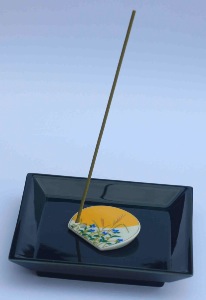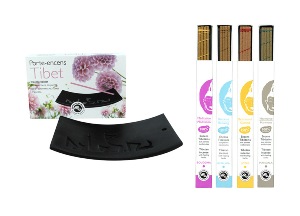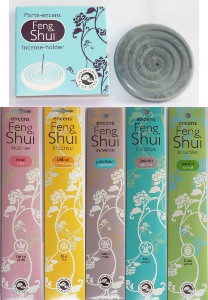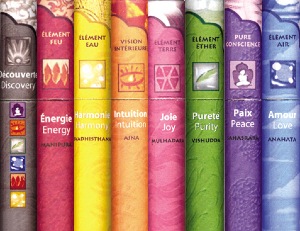Types Of Incense available and some benefits from burning them
|
Direct-burning incense (also called combustible incense) is lit directly by a flame and is the most commonly used type of incense. The glowing ember on the incense will continue to smoulder and burn away the rest of the incense without continued application of heat or flame from an outside source. Direct-burning incense is either extruded, pressed into forms, or coated onto a supporting material. Hence, the following types of direct-burning incense are common: |
|
Solid Stick
This stick incense has no supporting core and is completely made of incense material. Easily broken into pieces, it allows one to determine the specific amount of incense they wish to burn. This is the most commonly produced form of incense in Japan and it is generally considered as the highest quality incense type.
| |
Cone
Incense in this form burns relatively fast. Incense cones were invented in Japan in the 1800s. They are great when you want a fragrance to be powerful, delivered quickly and fill a large space.
|
Coil
Extruded and shaped into a coil without a core, this type of incense is able to burn for an extended period, from hours to days, and is commonly produced and used by Chinese people.
| |
Cored Stick (Joss Stick)
This form of stick incense has a supporting core of bamboo. The core is coated by a thick layer of incense material that burns away with the core. This type of incense is commonly produced in India and China. When used for worship in Chinese folk religion, cored incensed sticks are sometimes known as "joss sticks".
|
| Note: This list is not exhaustive - there is also powder incense, paper, rope and wood chips incense. | |
Vectis Karma- The Benefits Of Solid Incense
Specifically due to its production values, quality orientation and heritage we focus primarily on solid incense. All our Japanese incense sticks are in this format - whether from Nippon Kodo, Baieido, Shoyeido, Les Encens du Monde or Kousaido.
You will find that our Chinese Feng Shui incense sticks and our Ayurvedic (Indian) incense sticks are of the bamboo core type - this is traditional.
The Tibetan and Bhutanese incense sticks we stock are all belong to the 'solid incense' category.
| |  |
 | |
Japanese Incense Sticks
In Japan incense appreciation folklore includes art, culture, history, and ceremony. It can be compared to and has some of the same qualities as music, art, or literature. Incense burning may occasionally take place within the tea ceremony, just like Calligraphy, Ikebana, and Scroll Arrangement. However the art of incense appreciation or Koh-do, is generally practised as a separate art form from the tea ceremony; it is usually practised within a tea room of traditional Zen design.
Use
Incense is used for a wide variety of purposes, including during the ceremonies of the world's main religions (to overcome bad smells and repel insects). It purifies or improves the atmosphere and it is mainly used for aromatherapy, meditation and simple pleasure. |
| | |
Religious
Religious use of incense is prevalent in many cultures and may have their roots in the practical and aesthetic uses considering that many religions with not much else in common all use incense. One common motif is incense as a form of sacrificial offering to a deity. Such use was common in Judaic worship and remains in use for example in the Catholic, Orthodox and Anglican churches. Taoist and Buddhist Chinese also offer incense to ancestors, gods etc. | | Aesthetic
Many people burn incense to appreciate its smell, without assigning any other specific significance to it - i.e. consumed (used/burnt) solely for the contemplation or enjoyment of the refined sensory experience.
It smells good, it makes you feel good. It also lifts the spirit, clears the mind and allows you to select, create and deliver your own ambiance ... it's all good! | | Practical
Mosquito repellent is often manufactured in coil form with citronella and burned in a similar manner as incense.
Papier d'Arménie was originally sold as a disinfectant as well as for the fragrance.
|
Tibetan Incense
Respecting ancient texts and traditional recipes, these incenses are manufactured in Nepal in the clinic of Dr. Dolkar, a woman doctor, descendant of the 13th generation of famous Tibetan doctors of the Lhassa school. This incense is a means of financing her mission: to give consultations to the population for a very modest fee. Each composition corresponds to a different use:
- Buddha Meditation - meditational and ritual purposes
- Lotus Tranquility - medicinal herb for relaxation, calming, soothing
- Mandala Harmony - harmonising tensions, balancing energies and purifying the air
- Himalaya Relaxing - creating harmonious and calm atmospheres
| |  |
 | | Feng Shui (Chinese) Incense
Feng Shui is a Chinese art which dates back to over 3,000 years - the aims of which are to harmonise man with his environment. Incense can contribute and participate with the energies in your surroundings and relate to the five main elements - wood, fire, earth, metal and water. For instance, when the presence of one element is lacking or too feeble, objects which represent it are used to develop its presence.This range of Feng Shui incense by Floriesen is manufactured in the Canton region of China, from an incense paste similar to that used in Japanese incense, then spread around a thin stick of bamboo.
Feng Shui Incenses:
Subtle fragrances for the harmony of the 'Chi' - the energy of Life in your home |
Ayurvedic Incense from India
The Indian traditional use of incense aims at benefiting the 7 vital centres or Chakras. This is why it is composed of the finest natural essential oils, herbs, powders and resins.
The elements are also part of the Ayurveda medicine according to which each natural phenomena is made up of 5 classes: ether, air, fire, water and earth. Each element is represented by specific fragrances. The use of Ayurvedic incense sticks is then a tradition which aims at finding a personal balance.
| |  |
| | |
|
|